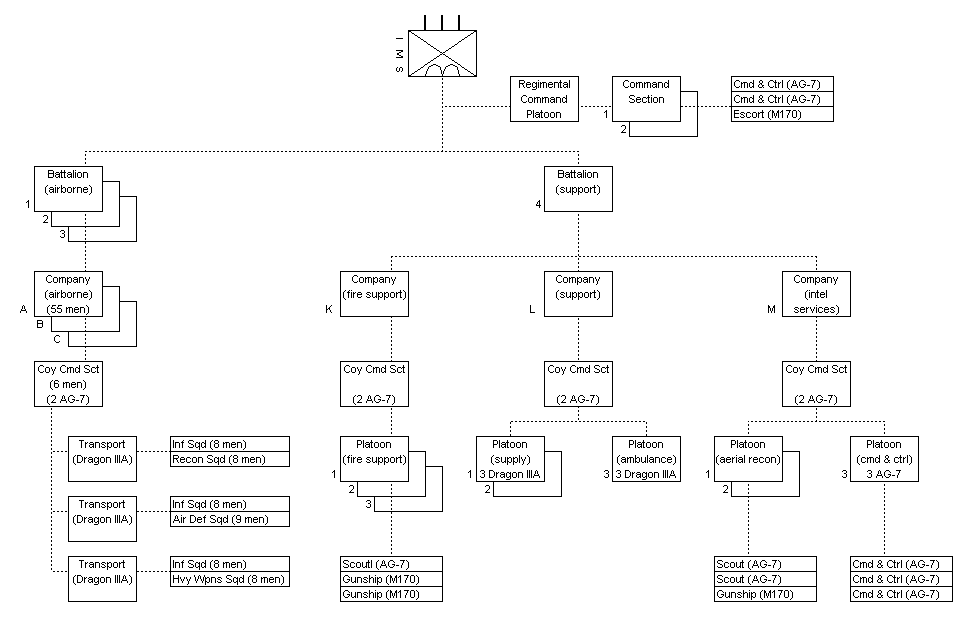

In 2301, IMS announced a major revision in the Table of Organization and Equipment (TO&E) for all of its ground military forces. This change was necessary due to changes in military doctrine and the renewed Kafer war offensive up the French Arm. Under the new TO&E, Airborne Combat Regiments (ACRs) underwent extensive re-organization, primarily due to the new Infantry Regiment TO&E.
The Airborne Combat Regiment is the latest type of regiment-sized unit mustered IMS. It is designed to be used as a rapid deployment force, seizing targets until conventional ground forces can relieve the ACR units. With each airborne company containing infantry, recon, air defense, and heavy weapons squads, they are ideally suited to this, and can provide defensive capabilities against most threats. However, ACR units are capable of long term deployment, and are often used in the role in terrain that is not favorable to ground vehicle transport.
Currently ACRs and HCR / HCB units are undergoing increased training together, with the ACRs being used as an initial strike force to seize objectives in advance of HCR / HCB units, or as strike troops; landing in the rear of enemy units to envelope the enemy between them and advancing ground forces. As well, the aerial fire support units are often used by other units as air support when necessary.
Airborne Combat, Hover Combat, and Hover Service Regiments are identified by a sequential numerical designation that indicates their chronological order of formation.
xxx ACR
xxx is a numerical designation for the regiment commencing from 101.

Airborne Combat Regiments consist of three airborne battalions and a support battalion; all controlled by a regimental command platoon. The regimental command platoon consists of two sections; each having two command and control AG-7 craft and one M170 escort craft.
Each airborne battalion contains three airborne companies. Each airborne company of fifty-five men is control by six men in two AG-7s, and consists of six squads carried in three Dragon IIIA transports. One transport carries an infantry squad (8 men) and a reconnaissance squad (8 men); the second transport carries an infantry squad (8 men) and an air defense squad (9 men); the third transport carries an infantry squad (8 men) and a heavy weapons squad (8 men). Therefore, each airborne battalion contains one infantry company, one reconnaissance platoon, and one air defense platoon.
The support battalion consists of three companies: fire support, support, and intelligence services. All companies are controlled by their own company command section of two AG-7 craft. The fire support company contains three platoons, each consisting of one AG-7 scout craft and two M170 gunships. The supply company contains two supply platoons each of three Dragon IIIA transports, and one ambulance platoon of three Dragoon IIIB medical evac craft. The intelligence services company contains two aerial reconnaissance platoons and a command and control platoon. Each aerial reconnaissance platoon contains two AG-7 scout craft and one M170 gunship; the command and control platoon contains three AG-7 craft.
Airborne Combat Regiments draw on other airborne units (Close Fire Support, Supply, Heavy Lift, Ambulance, Fighter/Bomber, etc.) to provide any necessary additional forces.
As of 2301, IMS has two Airborne Combat Regiments at full operational strength, with a third expected to be formed in 2302. There were two further ACRs expected to be formed in 2301, but with the shortage of men and the restructuring of all ground units, those forces have been re-allocated to existing units.
Before anyone jumps up and down and says 'That's not a Regiment, a regiment has yyy personnel!', please remember that this is my version of the 2300AD gaming universe. My perceptions of unit sizes and strengths are different from that of others. Also, this is a corporate military organization, not a national one; with economics as the bottom line, not nationalist pride.
These web pages developed and maintained by Terry A. Kuchta